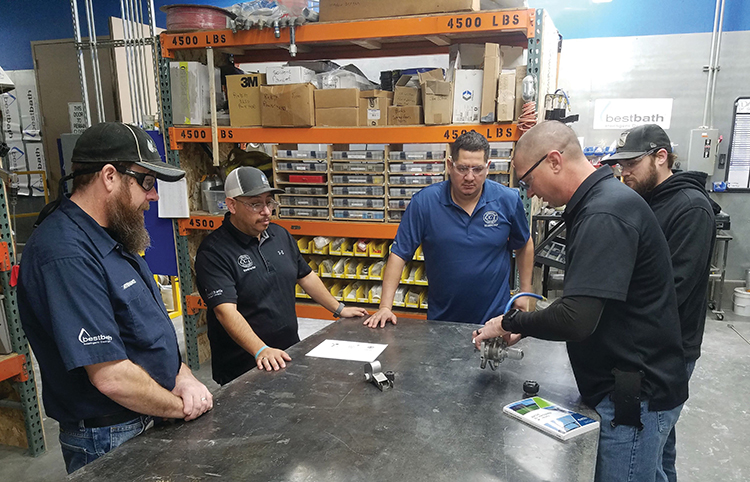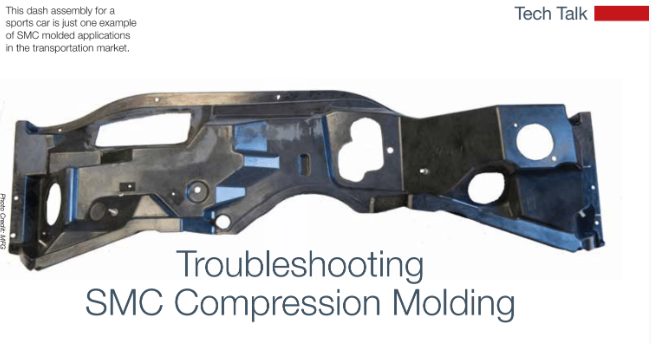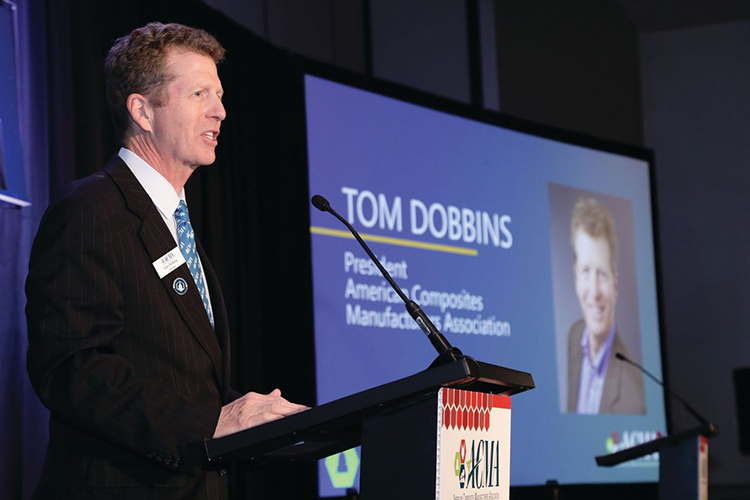

A Team Approach to Employee Training
Davis Technical College in Utah began offering a composite materials technology program 15 years ago. The 900-hour program introduces students to basic composite materials, techniques and procedures, then progresses through advanced composite skills. The success of the program hinges on collaboration with local companies. Corporate leaders participate in two partner meetings with the college annually and several visits to the campus per month.

“Our program is designed for industry, by industry,” says Wes Hobbs, national director of composites pathways for Davis Tech. “Currently, our students are getting jobs in aerospace, unmanned aerial vehicles, sporting goods, prosthetics and architectural industries.” The college boasts a 94% placement rate for students in the composite materials program, who graduate with both a local industry-driven certificate and ACMA’s Certified Composites Technician (CCT) designation.
Davis Tech’s program is a shining star in an industry that often struggles to find and retain qualified workers. “There is no doubt that every fabricator I talk to across ACMA and our customers all share a common strategic concern, and that’s labor,” says Reagan Stephens, COO of IP Corporation and chair of ACMA’s Education and Certification Committee.
“As an industry we’re challenged not only in finding employees, but are they going to have the necessary skill level and can we retain and grow those employees?”
IP Corporation utilizes several workforce development strategies, from CCT training for employees at all levels to internships for college students at its four factories. “We don’t bat a thousand, but we have several employees who went through our intern program and are now on our research and development staff,” says Stephens.
Challenges to Overcome
There are several challenges for companies trying to knock it out of the park when it comes to workforce development. “One of the biggest hurdles is that technology is outpacing the educational systems,” says Joannie Harmon Heath, workforce director at IACMI – The Composites Institute, a not-for-profit organization managed by Collaborative Composite Solutions Corporation. “We are at an intersection where we have rapid technology development and commercialization, but it takes time for the schools to build the programs [associated with those technologies]. The jobs today didn’t exist 10 or even five years ago.”
The issue for technical schools, community colleges and four-year universities is they have finite funding to create new programs and must meet metrics to graduate students who land jobs. “We haven’t made it to the tipping point where there is an abundance of jobs in emerging technologies,” says Harmon Heath, who leads IACMI’s efforts to expand composites training programs. “Part of our next phase is partnering with local economic development groups to bring new industry into regions. Then, we work hand-in-hand with educational partners to help build the appropriate programs.”
Another issue is high employer expectations in a niche industry that many people are unfamiliar with. Job seekers understand traditional materials like steel and aluminum, but fiber-reinforced polymer composites are a mystery to many. “We seek people who are technically qualified and can hit the ground running from day one,” says Stephens. “They need an appreciation for the types of materials involved in composites manufacturing – the sensitivity and potential hazards of the materials – as well as the ability to innovate and contribute to bettering the manufacturing process and overall productivity and profitability.”
Stephens knows that’s a big ask. For new employees without previous experience or qualifications, the learning curve is one to two years, he says. “How do we shorten that time so employees can contribute sooner rather than drain internal resources?” says Stephens. “That’s been the big challenge.”
The solution, says Harmon Heath, requires collaboration among industry organizations like IACMI and ACMA, colleges and technical schools, economic development organizations and composites companies. “Together, we can just do more,” she says. “No one group is an expert in all things, but we each bring a bit of expertise, a bit more reach and a few more resources.”
Industry Organizations Offer Programs
IACMI has leveraged numerous partnerships to create composites training opportunities. In the past several years, it has hosted approximately 100 internships, spearheaded hands-on workshops for 2,500 participants with industry and academic partners, and engaged more than 9,000 K-12 students in STEM activities. “Each partnership is part of an overall strategy to leverage what has previously been done and move the needle a little further,” says Harmon Heath.
Last year, the institute landed a three-year $5 million grant from the U.S. Department of Defense’s (DOD) Manufacturing Engineering Education Program (MEEP) to expand the successful composites training program led by Davis Technical College to four locations across the country. The goal is to fill the critical skills gap of DOD manufacturers with a qualified, adaptable workforce.
“We are selecting sites that are within the DOD manufacturing industrial base supply chain to make sure they have the talent to fill jobs at companies like Lockheed Martin, Boeing and small Tier 1 and Tier 2 providers, too,” says Harmon Heath. “We are going to set up technician-level community college programs based on the Davis Tech model, but contextualized for each region.”
One of the top priorities in choosing the four locations for training programs is industry involvement: There must be demand for composites technicians in the area, and local companies need to be willing to partner with the community college on curriculum. In addition, global leaders like Composites One are supporting the initiative by delivering workshops to support the continuous learning requirements for instructors. “We want instructors to be exposed to new processes and new materials and hear the voice of industry – the voice of their customer,” says Harmon Heath.
ACMA will also support the initiative through its CCT program. The association oversees nine certifications related to specific industry areas, such as advanced composites, compression molding, open molding, light resin transfer molding and wind blade repair. “Having a credible standard with consistent technical content on these various technologies and processes is something ACMA offers that is nowhere else to be found,” says Stephens.

Technical Colleges Jump on Board
Enterprise State Community College (ESCC) in southeastern Alabama is slated to be one of the first learning centers established through the MEEP grant. The college is an ideal fit, thanks in part to its close proximity to Fort Rucker, named a U.S. Army Aviation Center of Excellence in 2008, and the school’s aviation programs in aircraft maintenance and avionics technology.
ESCC is also one of a handful of schools that previously reached out to Hobbs at Davis Tech for advice on curriculum. “Our campus in Ozark, Alabama, has traditionally been focused on preparing aircraft mechanics. When we got some dollars to upgrade our composites lab through a regional workforce grant, I knew I didn’t want to end with just training mechanics,” says Danny Long, dean of instruction at Enterprise State Community College. “So I began looking for different credentials our students could possibly earn through instruction.”
Long found Davis Tech’s composite materials technology program through an online search and contacted Hobbs. The two hit it off right away. (It helps that Hobbs is an alumnus of Auburn University, just 100 miles north on U.S. Route 29.) Hobbs shared his program’s curriculum, some of which ESCC began using in its aviation program last summer. But the real game changer came when Hobbs, who will co-lead the national training program with IACMI’s Harmon Heath, asked Long if Enterprise State wanted to be the first community college partner on the MEEP grant.
“We are so excited for the opportunity,” says Long. “As far as I know, we’ll be the only community college in the state of Alabama – maybe even this entire part of the country – to offer such a program.” Pending final approval by governing bodies, ESCC will launch its composite manufacturing technology program in the fall, with enrolled students earning an associate’s degree in applied science. Davis Tech will help the school finalize curriculum that meets the area’s industry needs, set up the composites training lab and host a week-long train-the-trainer course for ESCC instructors. The instructors will also earn CCT – Instructor training through ACMA.
Long says the addition of the composites program will be an economic driver for southeast Alabama. “When we look at developing new programs for the college, we want them to meet the immediate workforce demand, but we also want to leverage the programs to recruit future businesses,” he says. “That’s where we see this composites program taking us.”
Economic Development Partners Offer Resources
Another one of IACMI’s strategic partners is the Robert C. Byrd Institute (RCBI) and its Apprenticeship Works program. RCBI was founded 30 years ago primarily to provide manufacturers in West Virginia with access to equipment and the training to use that equipment. In 2014, the institute led an effort to start an apprenticeship program for a flooring company. “It was so successful, and the U.S. Department of Labor liked it so much, that the DOL encouraged RCBI to apply for the first big round of funding for apprenticeships under its American Apprenticeship Initiative,” says Becky Calwell, program manager of Apprenticeship Works.
Since then, Apprenticeship Works has created DOL-recognized apprenticeship programs for 20 occupations that are being utilized at approximately 30 industry partners in 18 states. “Companies contact us from all over the country, and we help them implement apprenticeship programs at their facilities,” says Calwell. “We provide them the assistance and the tools to get programs up and running.”
The organization’s two most popular programs are for CNC operators and programmers and tool and die makers. But in the past two years, Apprenticeship Works has added newer occupations, such as additive manufacturing/3D printing technician. “One of the goals of the program from the beginning was to build out apprenticeships in occupations that hadn’t been recognized before,” says Calwell.
In 2019, Apprenticeship Works launched a program for composites technicians. It’s a natural fit for West Virginia, which has a dynamic aerospace industry. According to the state’s Economic Development Office, approximately 4,000 people are employed at 22 companies in the aerospace and aviation industry in West Virginia. And as with Apprenticeship Works’ other occupations, the program is available to companies in other states – and other industries aside from aerospace.
The composites technician apprenticeship is a one- to two-year program, depending upon the experience of the employee. The program covers several competencies, including safety compliance, fiber technology, materials, molding methods, shop practices, design, inspection and more.
Apprenticeship Works’ participation in MEEP is an ideal extension of the initiative. “We try to provide a pathway so that if a student trains at a community college or training center, then we partner with a local company and build out that career path for them to go from training to a company and into an apprenticeship,” says Calwell.
Composites Companies Bolster Training
Workforce education efforts by industry organizations, community colleges and economic development groups are critical, but composites companies must pull their weight, too – and not just as advisors providing occasional input on their workforce needs or program curriculum. One company that routinely evaluates its internal training to ensure it’s up to par is Bestbath Systems Inc., a manufacturer of FRP bathing products in Caldwell, Idaho.
In 2018, Bestbath instituted a career mapping initiative that outlines the requirements for employees to further their skill sets and advance within the company. “Career mapping gives hourly employees the foresight to know how they can move up the ranks from a beginning employee all the way up to a technician II,” says Frank Alvarez, facilities and maintenance manager for Bestbath.
The manufacturer has a six-step career ladder for its hourly employees: operator I, operator II, specialist I, specialist II, technician I and technician II. Employees must fulfill hands-on training, complete classes and meet designated employment anniversaries to move up the ladder. The specific requirements vary by department and are selected by Bestbath’s executive leadership team and departmental managers. For instance, employees in Alvarez’s department must know how to rebuild pumps, spray guns and other equipment prior to advancement. The production manager holds a controlled spray class a couple times a year that employees on the shop floor must attend.
No matter the department, employees who want to advance from specialist I to specialist II must earn and maintain their CCT – Open Molding. Alvarez and Hugo Castillo, continuous improvement leader at Bestbath, have earned CCT – Instructor designations and teach classes on site, breaking down the content into one-hour modules during work hours. Together, the instructors and employees review content in study guides, watch educational videos, view PowerPoint presentations and answer sample test questions at the end of each module.
“One of the most important things is making sure we have employee participation in the classes,” says Castillo. “It’s OK not to have all the information. As a group, we figure it out together.” Working together and encouraging one another has helped Bestbath employees achieve a high success rate on the CCT exam: The company currently has 38 Certified Composites Technicians.
Quality control is also paramount at Bestbath. “We put a big emphasis on continuous improvement and lean manufacturing,” says Castillo. One of the career mapping requirements encourages employees to either be a member of the safety committee for six months to one year, present lean items related to continuous improvement to the leadership team or introduce an A3 project (a structured problem-solving approach to a particular issue). “We give employees options so they are not pigeonholed into one prerequisite to complete their career mapping,” says Alvarez.
Well-designed workforce education programs ensure that every employee is operating at a high level, says Castillo. That, in turn, leads to the overall success of the company. It also helps spread a positive message about the industry as a whole.
“As composites manufacturers, if we don’t put in the effort to train employees, then we can’t complain when workers come in and don’t understand what we’re about,” says Castillo. “It’s up to us to educate not only the people at work, but in the community, too, catching people while they are young and getting them interested in composites.” Bestbath routinely holds facility tours for the local chamber of commerce and school kids. “Composites are the wave of the future,” says Castillo.
Securing the Industry’s Future
For composites to become widely accepted as the material of choice in the future, then solving the workforce development puzzle is imperative. “The biggest threat to workplace readiness is the availability of qualified human capital,” says Harmon Heath. “You can have the most robust technology, but if you don’t have a skilled workforce to execute it, it doesn’t matter.”
Preparing that workforce requires a team effort among industry, academic institutions, local and state governments and other interested parties. “It’s very hard for a company to do workforce development on its own. It’s only the really big players with big human resource departments that can do it themselves,” says Calwell.
Fortunately, it’s a good time for collaboration as is evident by IACMI’s recent MEEP grant and Apprenticeship Works’ new DOL-sanctioned composites technician apprenticeship. “Companies should take advantage of the fact that at this point in time, a lot of people want to help them,” says Calwell. “There are groups to help and money out there for workforce training.”

SUBSCRIBE TO CM MAGAZINE
Composites Manufacturing Magazine is the official publication of the American Composites Manufacturers Association. Subscribe to get a free annual subscription to Composites Manufacturing Magazine and receive composites industry insights you can’t get anywhere else.





